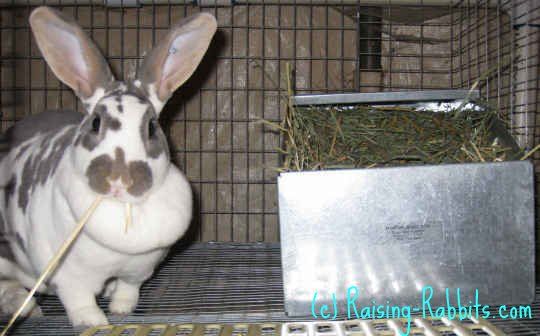Rabbits are one of the famous pets among people who take the pleasure of raising small animals. Irrespective of the breed, if you have made up your mind to get a female rabbit and subject her for breeding, you must know the precise duration of the pregnancy so you can provide the best kind of care.
Remember that pregnancy is a crucial stage because other lives are at stake. Proper care has to be implemented to ensure the survival of the litters. It may sound such a big responsibility for any rabbit raisers, but when they know and understand the concept of gestation among female rabbits, then things can be more manageable for them.
When can does become pregnant?
Pregnancy, as well as the giving of birth, is a crucial part in the lives of the rabbit. Although these creatures deliver birth instinctively, some rabbits may need some assistance to successfully deliver their baby rabbits. This is where the supervision of the owner comes in.
Ovulation in rabbits develops distinctly compared to other kinds of domestic animals like dogs and cats. Overall, sexual maturity and thereupon the first heat between the sixth and eighth months of life, though there are rabbit breeds that may develop their first heat on their fourth month.
How does heat act in rabbits?
Different from other animals, rabbits are always fertile, and they do not have a constant estrus period. Although they are more responsive during the six months of the year, ovulation is keyed on through the act of mating. That is, when a buck gets on top of a doe, it develops vaginal incitement, which evokes instinctive ovulation.
This period is classified into two levels. The first is the heat that occurs between 12 and 14 days when the female rabbit can conceive a baby. The other level is called diestrus – a period that lasts for around 4 days, during which the doe loses her passion to mate.
Gestation
A female rabbit, technically termed as the doe, can become sexually mature once it reaches the age of 6 months. Rabbits reproduce often as a method to preserve the species since they are positioned at the bottom part of the food chain and are considered to be preyed by many predators in the wild. It can be difficult to figure out the indications of pregnancy among female rabbits.
The period of gestation of a doe covers the period of conception up to the period of delivery of the kits or the baby rabbits. Normally, the gestation period of a female rabbit takes place for around 31 days. If counting 33 days and the doe has not given birth yet, the owner should bring her to the veterinarian to ensure that there would be no complications. After the 34th day, the fetuses may no longer survive and die inside the womb if they are still not born. A veterinarian may be able to induce the labor or remove the babies through surgery.
During the period of gestation, it can be hard to determine that your female rabbit is conceiving a baby as she may not behave any distinctly than before she was not conceiving a baby. However, some do behave more aggressively during the period of gestation. Some may fend off the headways of the male rabbit, and her appetite becomes noticeably increasing.
Behavior
You may also check whether the female rabbit is pregnant using palpitation. Gently lay the rabbit on an even surface and hold her still. Position your palm on her abdomen, just over the stomach, and graze through your fingers, cautiously back and forth. It is important not to exert any pressure when trying to palpitate the abdomen of the rabbit as it may cause the rabbit to abort. It would be best if you bring the rabbit to the veterinarian so they can perform an examination and specify in detail the manner of examining her.
You will notice some round bumps if the rabbit is pregnant. Counting between the eleventh and fourteenth day, if you place your fingers on the belly of the rabbit, you will be able to feel the fetuses. Feeling the stomach, you would associate the fetuses similar to marbles inside.
After the fourteenth day, you should avoid carrying or touching the rabbit. During this time, the doe is very fragile, and reckless handling may lead to unintentional abortion. Likely, the male rabbit should never be permitted to go near the female rabbit.
On the 28th day during the gestation period, the doe will start nesting, or setting up a nest for forthcoming delivery of her litter. The female rabbit shall pull out her fur to cushion the prepared nest and shall push hay or straw into the nest. This creates a fluffy bed and leavens the nest with her smell, which is pleasant to the newly-born kits. If you see your rabbit setting up a nest or pulling out her fur, this is a definite indication that she is bound to deliver her baby rabbits anytime soon.
When in captivity, the female rabbit may tend to hide. This may occur as minimal as one day before the expected delivery.
Common Signs of Pregnancy
Pregnant does exhibit more signs other than the visibly swollen belly. These signs include the following:
- Restlessness
- Aggression towards the buck
- Swollen breasts
- Increased consumption of water and food
- Setting up a nest – often by pulling out their fur
Kindling
The giving of birth of the litter of the baby rabbits or kits is referred to as kindling. Commonly, rabbits deliver their kits during the night or the early hours in the morning, although they may also give birth at some other moment. The hint is for them to sense security and safety.
Kindling can only last for around 10 to 30 minutes from start to finish. The moment the litter, commonly containing 7 to 13 kits, are given birth, the female rabbit keeps a distance from the baby rabbits. She will normally do this to guard the litter against the predators in the wild. The doe may feed on any born dead babies. Feeding is made two times a day and lasts for only around 5 minutes at a time.
Post-Partum
Once the litter is given birth, the male rabbit, also called as buck, must be kept distant from the litter so the babies can get higher chances of surviving. This will protect the babies and will also inhibit fertilization again since conception is probable during the first 72 hours after delivery. This may not only cause stress to your rabbit but will also inhibit it from nourishing the newborns during the period of lactation.
The doe may also attempt to mate with the female rabbit immediately after the delivery of the kits, which should be inhibited. The rabbit should not be permitted to engage in mating again within 42 days. Remember that mating your rabbit frequently may lead to some health issues.
The doe will typically feed the litter during the evening and only if she feels like doing it. The doe must be permitted to spend some time alone together with her litter to improve their chance to endure.
How to Conduct Help to a Rabbit Deliver her Litter
Like many animals, rabbits deliver their babies by instinct. Once the pregnancy is finished, the rabbit may not need your assistance to deliver the babies. Overall, female rabbits happen to deliver her babies at night-time or during a time when they think that no one would disturb or interrupt them.
You must simply give the rabbit a calm and peaceful environment and maintain your distance. Nevertheless, never lose your attention on everything to ensure that the delivery of the rabbit goes well. If you notice that something is not right, you may try to help her or, better yet, call the assistance of a veterinarian.
Caring for a Pregnant Rabbit
The period of gestation in female rabbits is normally calm and quiet. If there are lesser fetuses, you may not even detect the major differences occurring in the abdomen of the rabbit. Nevertheless, this does not imply that you can just leave the rabbit to do the entire process of gestation without your supervision. There are particular things to consider, and it is recommended to secure the rabbit the ideal conditions to ensure a smooth and easy pregnancy.
There should be proper rabbit care to make sure the pregnancy goes well. The healthy formation of the kits relies on the varied diets of the mother. Diet also impacts the ability of the rabbit to produce milk. Commonly, it is suggested to shift the diet of the rabbit from grass hay to alfalfa, and matching it with some carrots, lettuce, parsley, and carrot.
During the period of pregnancy, the rabbit will drink more amount of water than her usual intake. See to it that there is an available container with clean and fresh water just within her reach. Regularly refill the container.


